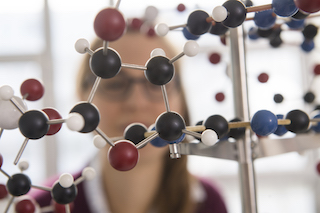Graph Neural Networks in Biology
| 392160 | Schönhuth / Pianesi | Summer 2024 | Tue 16-18 in X-B2-101 (S) |
Content
The recent surge of Machine Learning (ML) has opened up various opportunities when analysing biological datasets. Graph Neural Networks (GNNs) are a fairly new deep learning model capable of handling biological data in the best war overall. The seminar will start with an introductory lecture. The earliest and most recent approaches will be discussed, together with their use cases and drawbacks. The mini lecture will be followed by two lectures in which it will be presented how to write technical reports and how to prepare a good presentation. Then will be seminar presentations, to be presented in small groups of 1-2 students. The course will be held entirely in English.
Important Links
Papers
If there is any problem with accessing a paper, write an email to Luna Pianesi.
| Authors | Title | Year | Source |
| Gilmer et al. | Neural message passing for quantum chemistry | 2017 | https://arxiv.org/abs/1704.01212 |
| Zitnik et al. | Modelling polypharmacy side effects with graph convolutional networks | 2018 | https://academic.oup.com/bioinformatics/article/34/13/i457/5045770 |
| Gasteiger et al. | Directional message passing for molecular graphs | 2020 | https://arxiv.org/abs/2003.03123 |
| Withnall et al. | Building attention and edge message passing neural networks for bioactivity and physico-chemical property prediction | 2020 | https://jcheminf.biomedcentral.com/articles/10.1186/s13321-019-0407-y |
| Guo et al. | Few-shot graph learning for molecular property prediction | 2021 | https://arxiv.org/abs/2102.07916 |
| Li et al. | Graph representation learning in biomedicine and healthcare | 2022 | https://www.nature.com/articles/s41551-022-00942-x |
| Vrcek et al. | Learning to untangle genome assembly with graph convolutional networks | 2022 | https://arxiv.org/abs/2206.00668 |
| Stärk et al. | EquiBind: geometric deep learning for drug binding structure prediction | 2022 | https://arxiv.org/abs/2202.05146 |
| Garcia Satorras et al. | E(n)-equivariant graph neural networks | 2022 | https://arxiv.org/abs/2102.09844 |
| Liu et al. | Generating 3D molecules for target protein binding | 2022 | https://arxiv.org/abs/2204.09410 |
| Alsentzer et al. | Deep learning for diagnosing patients with rare genetic diseases | 2022 | https://www.medrxiv.org/content/10.1101/2022.12.07.22283238v1 |
| Roohani et al. | Predicting transcriptional outcomes of novel multigene perturbations with GEARS | 2023 | https://www.nature.com/articles/s41587-023-01905-6 |
| Huang et al. | Zero-shot drug repurposing with geometric deep learning and clinician centered design | 2023 | https://www.medrxiv.org/content/10.1101/2023.03.19.23287458v2 |
| Deng et al. | CHGNet: pretrained universal neural network potential for charge-informed atomistic modelling | 2023 | https://arxiv.org/abs/2302.14231 |
| Klein et al. | Timewarp: transferable acceleration of molecular dynamics by learning time-coarsened dynamics | 2023 | https://arxiv.org/abs/2302.01170 |
| Cao et al. | Learning large graph property prediction via graph segment training | 2023 | https://arxiv.org/abs/2305.12322 |
| Gao et al. | Double equivariance for inductive link prediction for both new nodes and new relation types | 2023 | https://arxiv.org/abs/2302.01313 |
| Lee et al. | A principal odour map unifies diverse tasks in olfactory perception | 2023 | https://www.science.org/doi/10.1126/science.ade4401 |
| Viñas et al. | Hypergraph factorization for multi-tissue gene expression imputation | 2023 | https://www.nature.com/articles/s42256-023-00684-8 |
| DeZoort et al. | Graph neural networks at the Large Hadron Collider | 2023 | https://www.nature.com/articles/s42254-023-00569-0 |
| Joshi et al. | gRNAde: geometric deep learning for 3D RNA inverse design | 2024 | https://arxiv.org/abs/2305.14749 |
| Bose et al. | SE(3)-stochastic flow matching for protein backbone generation | 2024 | https://arxiv.org/abs/2310.02391 |
| Li et al. | Contextualizing protein representations using deep learning on protein networks and single-cell data | 2024 | https://www.biorxiv.org/content/10.1101/2023.07.18.549602v2 |
| Riebesell et al. | Matbench discovery: a framework to evaluate machine learning crystal stability predictions | 2024 | https://arxiv.org/abs/2308.14920 |
| Wong et al. | Discovery of a structural class of antibiotics with explainable deep learning | 2024 | https://www.nature.com/articles/s41586-023-06887-8 |
Time table lecture
| Date | Topic |
| 09.04.2024 | Organization (slides), Introduction (slides), Glossary (slides) |
| 16.04.2024 | No lecture |
| 23.04.2024 | How to present (slides) |
| 30.04.2024 | GNN applications |
| 07.05.2024 | How to write reports |
| 14.05.2024 | 1st presentation: 4pm “Modelling polypharmacy side effects with graph convolutional networks” |
| 21.05.2024 | 2nd presentation: 4pm “Generating 3D molecules for target protein binding” |
| 28.05.2024 | 3rd presentation: 4pm “E(n)-equivariant graph neural networks” CANCELLED |
| 28.05.2024 | 3rd presentation: 5pm “Deep learning for diagnosing patients with rare genetic diseases” |
| 04.06.2024 | 4th presentation: 5pm “Neural message passing for quantum chemistry” CANCELLED |
| 11.06.2024 | no seminar session |
| 18.06.2024 | no seminar session |
| 25.06.2024 | 5th presentation: 4pm “Learning large graph property prediction via graph segment training” |
| 25.06.2024 | 6th presentation: 5pm “Graph neural networks at the Large Hadron Collider” |
| 02.07.2024 | 7th presentation: 4pm “Graph representation learning in biomedicine and healthcare” |
| 02.07.2024 | 8th presentation: 5pm “Few-shot graph learning for molecular property prediction” |

